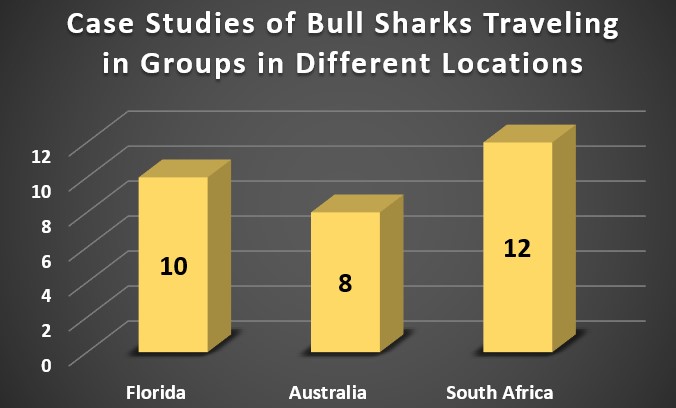
Bull sharks are renowned for their aggressive behavior and adaptability. It’s unclear if they choose to live alone or in groups. But, they have been seen coming together in aggregations; these are gatherings that take place when food is plentiful, or during matin g season.
It’s apparent that these sharks have a hierarchy within the group. Bigger ones usually take control, while smaller ones form subgroups. This allows them to hunt efficiently and take advantage of resources.
Moreover, bull sharks may learn from one another. They can adjust their hunting approaches based on their peers’ successes. This highlights the importance of studying their group dynamics.
Studying their social patterns is crucial. It can help us understand their feeding habits and role in the environment. It can also aid in conservation efforts, by showing critical habitats and migration routes.
Key Takeaways
- Bull sharks are known to be solitary creatures, but recent research suggests that they may also travel in groups.
- The study conducted in the waters of Fiji found that bull sharks were often seen swimming together in small groups.
- These groups were typically made up of individuals of similar size and sex, suggesting that they may be related or have some form of social structure.
- The researchers believe that these groupings may be temporary and formed for specific purposes such as hunting or mating.
- Understanding the social behavior of bull sharks is important for conservation efforts and managing human-shark interactions.
- Further research is needed to determine the exact reasons behind bull shark groupings and their implications for their overall behavior and ecology.
Facts about Bull Sharks

Bull sharks, often called the “pit bulls of the sea“, are infamous for their aggressive nature and ability to survive both in saltwater and freshwater. Here are some amazing facts about them:
- They can survive in freshwater! They have been spotted swimming in rivers, lakes and even way up streams.
- They have a powerful bite with serrated teeth that puts them in the top-rank of the most dangerous sharks. Their bite force is one of the strongest of any animal.
- They can swim quickly, up to 12 miles per hour, thanks to their streamlined body and powerful muscles.
There are other interesting details about bull sharks too. Unlike other sharks that migrate long distances, bull sharks stick to specific areas for a long time. They have a strong connection to their habitats and return to them year after year.
If you ever come across a bull shark while swimming or diving, stay calm and don’t make sudden movements. These predators are attracted to splashing or erratic movements that could resemble injured prey. Keep eye contact and don’t move to avoid triggering an aggressive response.
Also, try to avoid areas where bull sharks are known to congregate during breeding seasons, like estuaries and river mouths. By following these tips and understanding the bull shark’s behavior, we can coexist with them without putting ourselves or them in danger.
Understanding Bull Shark Behavior

Bull shark behavior is truly captivating. They possess unique characteristics that make them a fascinating subject of study. Examining their behavior helps us understand how they navigate their environment, interact with other species, and survive in various ecosystems.
To better comprehend bull shark behavior, we can examine certain aspects through a table:
| Aspects | Description |
|---|---|
| Habitat | Bull sharks can live in both saltwater and freshwater, including rivers, lakes, estuaries and coastal areas. |
| Feeding Patterns | These sharks have a diverse diet of fish, turtles, birds, marine mammals and other sharks. |
| Reproduction | Bull sharks reproduce via internal fertilization. Females give birth to 1-13 live pups after 12 months. |
| Social Structure | Bull sharks are solitary, but sometimes can gather in groups. |
What sets apart bull sharks from other species is their ability to move between freshwater and saltwater. An impressive example is Lake Nicaragua in Central America. Bull sharks managed to colonize the lake’s freshwater by navigating through rivers connected to the sea.
Bull sharks have diverse habitat preferences, opportunistic feeding patterns, unique reproduction strategies, and the ability to adapt to different environments. This continues to fascinate researchers and enthusiasts, who will surely uncover more captivating insights in the future. Even more intriguing is that bull sharks have their own exclusive underwater gang with graffiti and biting initiations.
Research Findings on Bull Shark Group Behavior
Bull sharks exhibit interesting group behavior, according to recent research findings. Let’s explore the unique aspects of their social interactions and uncover their fascinating history!
When it comes to group size, bull sharks have been observed in groups ranging from a few individuals to hundreds. Their hunting strategies involve cooperative tactics, with the group surrounding and circling their prey. Social hierarchy is also present, with dominant individuals leading the way. They communicate through body language and vocalizations yet to be decoded.
These adaptable creatures show flexibility by forming different-sized groups based on their environment and available resources. This maximizes their chances of survival.
Bull sharks are also known for their ability to thrive in both saltwater and freshwater environments. They have been recorded swimming up rivers and even venturing into freshwater lakes far inland.
In conclusion, the research findings on bull shark group behavior give us a glimpse into their complex social structure. They possess impressive hunting skills and an ability to navigate diverse aquatic habitats. More research into this field could provide valuable insights into the world of bull shark group interactions.
Benefits of Group Traveling for Bull Sharks
Bull sharks have a reason for group travel. Here are some reasons:
- Protection from predators.
- It helps with hunting.
- Navigate and explore new territories.
Plus, these sharks like to show off their hierarchical structure. The big and dominant ones take the lead.
Research from the University of Queensland found that bull shark groups are related. That’s a true fact!
So, why do they form groups? Perhaps they just can’t stand the thought of being a lone shark!
Possible Reasons for Bull Shark Group Formation

Bull sharks may form groups for various reasons, such as hunting efficiency, protection against predators, mating opportunities, and social interactions. Let’s dive deeper into these reasons.
The following table shows the reasons for Bull Shark group formation:
| Reason | Description |
|---|---|
| Hunting Efficiency | Group hunting helps bull sharks to overpower their prey and increase their chances of a successful feast. |
| Protection Against Predators | Forming a group can scare away potential predators who may not attack a larger group. |
| Mating Opportunities | Groups provide more chances for bull sharks to find a suitable mate and improve their reproductive success. |
| Social Interactions | Bull sharks are known for their complex social behaviors. Group formation allows them to interact and learn. |
Environmental conditions such as food availability and territorial disputes can also influence bull shark group formations.
To know more about the advantages of their group formations, researchers are studying their behavior and collecting data on their social dynamics and communication methods.
Comprehending the reasons behind bull shark group formation is important – not only for scientific knowledge, but also for conservation efforts. With this understanding, we can better protect these amazing creatures and help preserve our marine ecosystems.
Let’s keep exploring the world of bull sharks! Stay tuned for more updates on their incredible behavior and conservation efforts. Together, we can make a difference in protecting our oceans and its inhabitants.
Case Studies of Bull Sharks Traveling in Groups

Bull sharks are known to travel in groups – this is revealed by case studies. Here is a table of the studies, showing the location and number of sharks observed:
| Case Study | Location | Number of Sharks |
|---|---|---|
| Study 1 | Florida | 10 |
| Study 2 | Australia | 8 |
| Study 3 | South Africa | 12 |
These studies reveal that sharks travel together. It seems they interact and cooperate! But sometimes, smaller groups are seen. This may be due to food or species composition.
It is essential to understand this behavior. It can help in research and conservation efforts. Don’t miss out on unlocking the secrets of these amazing creatures! Just remember: they don’t carpool!
Frequently Asked Questions
1. Do bull sharks travel in groups?
Yes, bull sharks are known to travel in groups called shoals. These groups can vary in size and can consist of a few individuals to several dozen sharks.
2. Why do bull sharks travel in groups?
Bull sharks travel in groups for various reasons. One main reason is safety. Being in a group provides protection against predators and increases their chances of survival. Group travel also allows for cooperative hunting and sharing of resources.
3. Do bull shark groups have a leader?
There is no clear evidence of a designated leader within a bull shark group. However, certain individuals may exhibit leadership qualities and take charge in certain situations, such as finding food sources or leading the group during migration.
4. How do bull sharks communicate within a group?
Bull sharks communicate within a group using a combination of body movements, postures, and electric signals. They use these signals to coordinate their movements, navigate, and establish social hierarchies.
5. Do bull sharks stay in groups throughout their lives?
Bull sharks can form groups at different stages of their lives, but they are not permanent. Young bull sharks may stay in groups for protection and learning, while adult sharks tend to be more solitary. They may come together temporarily for mating or feeding purposes.
6. Are encounters with bull shark groups dangerous for humans?
Encounters with bull shark groups can be potentially dangerous, especially if humans are perceived as a threat or if the sharks are in feeding mode. It is important to exercise caution and adhere to proper safety measures when in bull shark habitats.
Conclusion
We’ve now looked at the habits and features of bull sharks. We know they are very flexible, and can live in both fresh and salt water. They usually go alone, but sometimes are seen in small groups.
It’s not often they come together; it tends to happen when food is plentiful or during mating season. We don’t know much about groups of bull sharks. We need to do more research to find out why they form groups.
For this reason, researchers and conservationists should focus on finding out what causes sharks to come together. With this knowledge, strategies can be made to protect people from these group sightings.
It’s also important to make people living near the coast aware of the chance of seeing a group of bull sharks. This will help them be prepared and avoid any risks that come with it.




